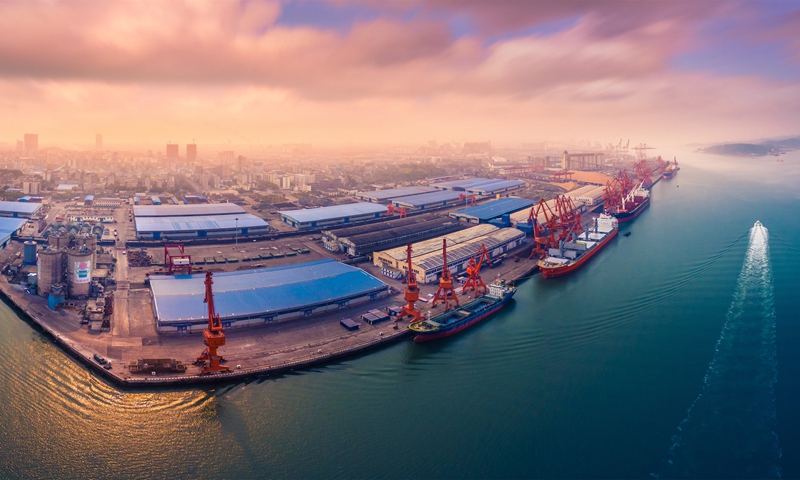
The Fangcheng Port at Beibu Gulf in South China's Guangxi Zhuang Autonomous Region Photo: VCG
China on Thursday launched a roadmap to construct the Beibu Gulf urban cluster in Southwest China, indicating more policy support for the region that would be key in facilitating commodity trade with neighboring Southeast Asian Nations (ASEAN) economies, and laying the ground for a more integrated industrial chain.
The roadmap, seen in the 14th Five-Year Plan (2021-25) of the region, lists a range of detailed development plans highlighting industries from energy storage, marine economy to infrastructure connectivity and digitalization.
A particular focus goes to energy. As the plan noted that relying on current facilities such as the Beihai liquefied natural gas (LNG) receiving terminal, the region will be built into an offshore natural gas hub and oil and gas storage base.
The region also vows to expand imports of resource products, improve capacity of the agricultural products imports, develop crude oil, ore, coal and other commodity distribution transactions and supply chains, and strengthen cooperation with ASEAN.
The region also plans to launch a China-ASEAN bilateral local currency business innovation experiment, and build an ASEAN-oriented yuan pricing and trading platform.
"With China's rising energy imports, the current facilities for both LNG and oil products are far from being enough, so filling the gap will be a long-term effort," Lin Boqiang, director of the China Center for Energy Economics Research at Xiamen University, told the Global Times on Thursday.
China's total LNG imports stood at nearly 80 million tons in 2021, making it the world's largest LNG importer, according to customs data.
Lin noted the scale of the storage hub could be smaller than those in the east of the country, since China's energy trade with ASEAN is relatively small. "Grain and other commodities' trade is larger."
LNG terminals are located along China's coastal cities from the northeast to the south. In February, the country approved the construction of two more LNG terminals, in Putian, East China's Fujian and Huizhou, South China's Guangdong Province with an annual receiving capacity of more than 11 million tons and a total investment of nearly 12 billion yuan ($1.89 billion).
Apart from building the region into an important energy resource storage and transportation base, the plan vows to accelerate marine economy development in the region, and it will continue to deepen the cooperation and construction of cross-border industrial and supply chains with ASEAN members and other RCEP economies.
By 2025, the Beibu Gulf urban cluster will be further developed, with the region's urbanization rate rising by 5 percentage points, the level of integrated development will continue to improve, and a blue bay urban cluster with a beautiful environment, vibrant economy and high-caliber life will be initially completed, said the plan.
Located in the southwestern part of China, the Beibu Gulf urban cluster is adjacent to Guangdong, Hong Kong, and Macao, and it also neighbors Southeast Asia.
The development of the region will also promote strategic interactions between the 21st Century Maritime Silk Road and the Silk Road Economic Belt, Chinese experts say.
Trade between China and ASEAN has skyrocketed since the two sides established dialogue relations. In 2021, ASEAN was China's top trading partner for the second consecutive year, with bilateral trade in goods reaching a record high of $878.2 billion.
Global Times




